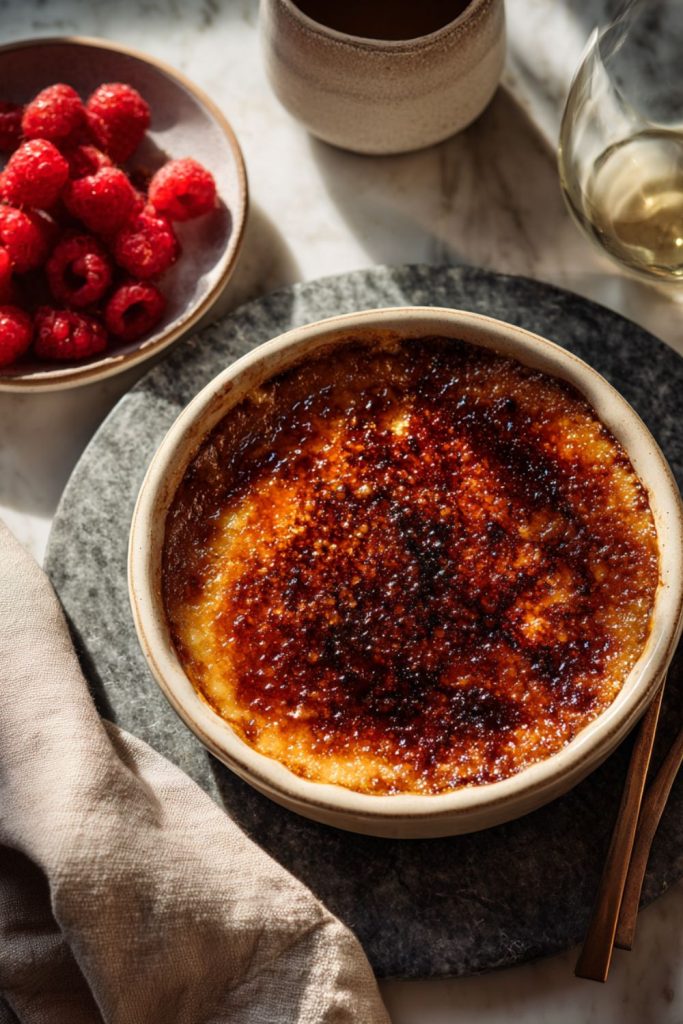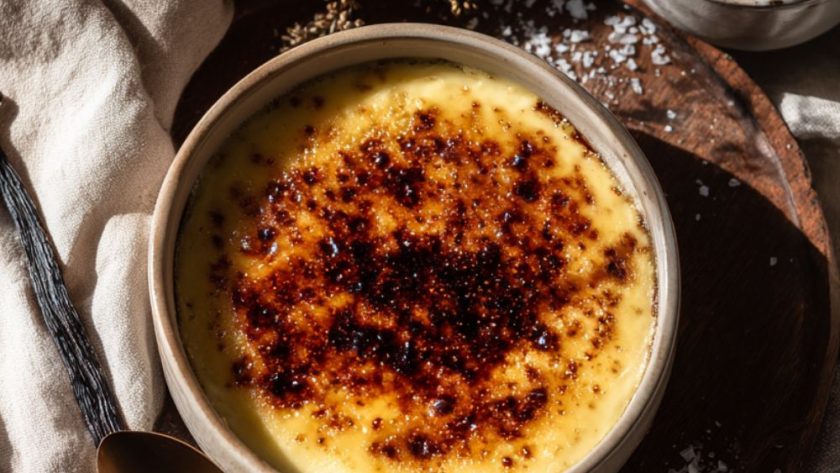This creamy Nigella Creme Brulee is made with rich double cream, a real vanilla pod, fragrant egg yolks, and both caster and demerara sugar. This recipe creates a decadent dessert with a satin-velvet custard base and a perfectly crisp, crackable sugar topping. It’s the perfect showstopper for a special occasion dinner party and makes enough to serve 6-8 people.
Nigella Creme Brulee Ingredients
- 600 ml double cream
- 1 vanilla pod
- 8 large egg yolks
- 3 tablespoons caster (superfine) sugar
- 6 tablespoons demerara sugar, for the topping

How To Make Nigella Creme Brulee
- Prepare your station: Place a pie dish (about 20cm or 8 inches) in the freezer for at least 20 minutes. As a precaution, half-fill your sink with cold water; you can plunge the saucepan in if the custard looks like it might split.
- Infuse the cream: Pour the double cream into a saucepan and add the vanilla pod. Gently heat the cream until it just reaches its boiling point, but do not let it fully boil.
- Create the custard base: In a separate bowl, beat the egg yolks and caster sugar together. While still beating, slowly pour the hot, vanilla-infused cream over the egg mixture.
- Thicken the custard: Rinse and dry the saucepan, then pour the custard mixture back into it. Cook over medium heat for about 10 minutes, stirring constantly, until the custard thickens to a rich, voluptuous consistency. It should coat the back of a spoon.
- Chill the custard: Once thickened, remove the vanilla pod. Pour the custard into the chilled pie dish. Allow it to cool to room temperature, then place it in the refrigerator until it is completely cold and set.
- Create the sugar crust: When ready to serve, sprinkle the demerara sugar evenly over the top of the cold custard. Use a kitchen blowtorch to melt and caramelize the sugar until you have a hard, blistered, tortoiseshell-like crust.
- Rest before serving: If you place the dish back in the fridge after torching, remember to take it out about 20 minutes before serving to allow it to come to the perfect temperature.
Recipe Tips
- Use a Real Vanilla Pod: For the most authentic and deeply aromatic flavor, a real vanilla pod is essential. It imparts beautiful black vanilla specks into the custard that you can’t get from extract.
- Cook Low and Slow: If you are worried about the custard splitting, cook it over low heat. Constant stirring is key to prevent the eggs from scrambling at the bottom of the pan.
- Temper the Eggs Carefully: Pouring the hot cream into the egg yolks slowly while whisking is a technique called tempering. It gently raises the temperature of the eggs, ensuring a smooth, silky custard instead of a scrambled mess.
- Don’t Skip Chilling the Dish: Pouring the hot custard into a freezer-chilled dish helps it cool and set more quickly and evenly, contributing to its perfect final texture.
What To Serve Creme Brulee
This Nigella Creme Brulee is a magnificent dessert all on its own. The contrast between the cold, creamy custard and the warm, crunchy topping is the main event. Serve it with a small cup of strong espresso or black coffee to cut through the richness. For a touch of freshness, you can place a few fresh raspberries or a crisp shortbread cookie on the side. A small glass of a sweet dessert wine like Sauternes also pairs beautifully.

How To Store Creme Brulee Leftovers
- Refrigerate: You can prepare the custard base and store it in the pie dish, covered with plastic wrap, in the refrigerator for up to 2 days. For the best result, only add and torch the sugar topping right before you plan to serve it. Leftovers with the sugar crust can be refrigerated, but the top will lose its crunch and become watery after a few hours.
- Freeze: Freezing is not recommended. The freezing and thawing process will ruin the delicate, silky texture of the custard, causing it to separate and become watery.
Nigella Creme Brulee Nutrition Facts
- Calories: 485 kcal
- Total Fat: 45g
- Saturated Fat: 26g
- Cholesterol: 380mg
- Sodium: 45mg
- Total Carbohydrate: 18g
- Sugars: 18g
- Protein: 6g
Frequently Asked Questions
- What can I do if I don’t have a kitchen blowtorch? If you don’t have a blowtorch, you can use your oven’s broiler. Place the chilled, sugar-topped custard on a baking sheet and position it about 4-6 inches from the broiler element. Watch it very carefully, as the sugar can burn in seconds.
- Why did my custard not set properly? If your custard is runny, it likely wasn’t cooked long enough on the stovetop. It needs to be thick enough to coat the back of a spoon before you pour it into the dish to chill. Be patient during the cooking process to ensure it thickens properly.
- Can I use individual ramekins instead of one large dish? Absolutely. This recipe works perfectly for 6-8 individual ramekins. The cooking and chilling process is the same, but serving individual portions can be very elegant for a dinner party.
- What is the difference between caster sugar and demerara sugar? Caster sugar is a very fine granulated sugar that dissolves easily, making it perfect for the custard base. Demerara sugar has large, coarse crystals that don’t dissolve as quickly, which is why it’s ideal for creating that thick, crunchy caramelized topping.
More Nigella Lawson Recipes:

Nigella Creme Brulee
Description
This Nigella Creme Brulee recipe creates a classic and elegant dessert. A rich, silky custard made from double cream, egg yolks, and a real vanilla pod is chilled until set, then topped with a layer of demerara sugar that is caramelized to form a hard, crackable crust.
Ingredients
Instructions
- Heat the cream and vanilla pod in a saucepan until just boiling.
- In a bowl, beat the egg yolks and caster sugar. Slowly pour the hot cream into the egg mixture while whisking constantly.
- Return the mixture to the saucepan and cook over medium heat, stirring, for about 10 minutes until the custard thickens.
- Pour the thickened custard into a chilled 8-inch pie dish and refrigerate until completely cold and set.
- Sprinkle the top with demerara sugar and use a kitchen blowtorch to caramelize it until a hard crust forms. Let rest for 20 minutes before serving.

